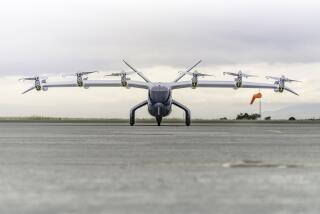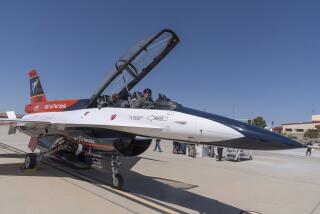2 Giants Wrestle for Pact to Make the Skies Safer : Air Traffic Control System Obsolete; Hughes and IBM Vie to Design a New One
- Share via
Abattle of brains, financial muscle and corporate gamesmanship is being waged by two industrial leaders of high technology for a multibillion-dollar federal award to build a public works project of critical national importance.
Hughes Aircraft and International Business Machines are preparing to submit fixed-price bids later this year to develop and produce a new U.S. air traffic control system, a formidable undertaking that could easily grow into a program worth $5 billion to $10 billion over its lifetime.
The contest has matched the corporate egos of two institutions that have played major roles in the advancement of technology over the last four decades but have seldom been in direct competition. It also squares off for the first time the enormous resources of IBM against those of General Motors, the parent of Hughes.
The competition for the right to build the Federal Aviation Administration’s Advanced Automation System, or AAS, is being fought on technical ground but with strategies meant to weaken the opponent and gain small advantages by surprise. The ultimate winner will seize a unique opportunity for leadership of a huge market that is expected to reach far beyond the one-time FAA award.
“It is the major growth area in the company,” Albert Wheelon, Hughes’ chairman-elect, said in a recent interview. “We believe the FAA program will be the bellwether for a whole new round of these things around the world. The FAA job is big, but it is more so in terms of where this leads.”
AAS will be a nationwide network of computers and video displays that will allow controllers to direct and navigate aircraft traffic more efficiently and safely. The two firms are designing the system under “cost-plus” type contracts that were issued in August, 1984, and have surpassed $400 million in combined funding for research and development.
They have also enlisted teams of subcontractors for some of the specialized tasks in the program, moves that have joined the East Coast’s Raytheon with IBM and West Coast Lockheed’s Sanders unit with Hughes.
“These really are the premier combinations of companies to be going after this program,” said Leland F. Page, the FAA’s director of the Advanced Automation System program. “Both companies have outstanding credentials. The corporate officers at the highest levels are committed to the program and have given it a high priority.” And the high priority assigned to AAS is not limited to the contractors. The increasingly urgent need for a complete overhaul of the nation’s air traffic control system is broadly accepted by Congress and the FAA.
Nonetheless, the program is already mired deep in the sort of political controversy that only a big aerospace program can generate. It has experienced schedule delays, cost overruns, acrimonious congressional hearings, a series of investigative reports, finger-pointing and wide-ranging mutual distrust among some government institutions. It could be just business as usual in Washington--or an inauspicious start to a risky venture.
“I am not sure we could avoid finger-pointing regardless of how good the system is,” remarked Rep. Norman Mineta (D-Calif.), chairman of the House Public Works and Transportation Committee’s aviation subcommittee.
Still in Its Infancy
The new computerized system that has created such hand-wringing is only in its infancy. When mature, it will be the centerpiece of the FAA’s effort to come to grips with the explosive growth of the nation’s air traffic. The existing FAA system at 20 regional control facilities around the nation, built originally by IBM, is a patchwork of modifications and additions over the past two decades. It is based on obsolete 1960s computer technology, using vacuum tubes and drum-type memory devices.
“A desktop personal computer is more powerful than some of these machines at the FAA centers,” Mineta said. “It’s ludicrous.”
The mainframe computers that operate the system went out of production at IBM long ago and now break down with alarming frequency. Last month, for example, the computer system in the Denver region, which controls traffic over the nation’s heartland, was out of operation for a week, the longest such breakdown in history, according to the General Accounting Office.
Even when it operates, the current IBM system is swamped by the increasing traffic. “When this system was put in in the late 1960s, it was built to operate at 50% capacity, and if it operated at more than that, its performance would begin to degrade,” Mineta observed. “We are now at about 90% capacity.”
What is more, the system lacks the capabilities that modern equipment would have to reduce the work load of the air traffic controller, a job that all too often takes workers to the limits of their psychological endurance. The video display technology at any game arcade is superior to what the FAA has now, experts say.
Telephone Analogy
“When I was a kid, AT&T; used to route calls by having ladies at switchboards,” Hughes’ Wheelon recalled. “They had jacks and they hooked everybody up. AT&T; began making projections . . . and found that in 20 years, they were going to have to have every lady in the United States as a telephone operator. Well, what we have here isn’t that bad, but it’s like that.”
AAS will not come one year too soon. The FAA projects that aircraft operations, meaning takeoffs and landings, will grow 68% by the year 2000 and that passenger traffic will grow 144%. “No thinking person would argue that we don’t need to replace the equipment we now have that is 20 years old,” Page said. “It is old stuff.”
So far, AAS is about one year behind schedule and about 100% over budget, Page acknowledged. He blames overly optimistic schedules that were laid out by earlier managers of the program and additional capabilities that have been planned. The General Accounting Office, which has been a persistent critic of the Federal Aviation Administration’s management of AAS, projects that eventually the AAS will be eight years late and will grow even more costly.
Money is not the greatest concern, unlike a lot of over-budget programs. As almost everybody agrees, the nation needs the best air traffic control system it can get. If the new system prevents even one accident, it would be worth whatever additional costs are incurred.
The settlement costs of an airliner crash can be up to $1 million per death; a particularly bad crash could cost upwards of a half-billion dollars, an attorney who specializes in aviation accidents said. Of course, the non-financial costs of the human loss are incalculable.
Of greater concern to the GAO than the budget problems is the FAA’s current plan to cut off the competition and select a winner before the system is ever tested operationally, which the GAO believes is fraught with technical risk.
“They want to go straight from design into production,” said Carl Palmer, the associate director of GAO’s information management and technology division. “We want to see them develop and test critical functions and show (that) they operate. A lot of our recommendations came out of the experience of the Defense Department and NASA.”
Track Record Questioned
Page, the FAA’s program director, responded: “I am not so sure that the Department of Defense’s track record is one we want to emulate. The cost of following the GAO would be unconscionable, in my opinion.” He said the cost of having both contractors produce operating systems competitively would push the development cost up to a half-billion dollars. The essence of AAS is not computer hardware, but the integration of a complex system and developing software for it. Both firms will use some IBM computers in their proposed sysems.
To create the automated air traffic control system of the future, the FAA has laid out an ambitious road map that includes the eventual replacement of hardware at nearly 250 existing airport towers and radar facilities across the nation and creation of a new set of instructions to govern how aircraft are controlled.
It is all part of the National Airspace System Plan, of which AAS is the largest component. The other parts include new radars, instrument landing systems, voice communications systems and an array of other navigational aids.
Included in the AAS alone is the production of an estimated 6,600 controller work stations. By one estimate, a single controller work station in the future will have more computing power than an entire regional control site does today. The cost is estimated at $100,000 to $200,000 per console.
As its name implies, the goal of the AAS will be to automate the job of air traffic control, turning over many of the control functions of the job to computer systems. Based on the productivity benefits of AAS, the FAA believes that it will be able to cope with future traffic demands with no increase in its current work force of about 9,500 controllers assigned to jobs actively controlling aircraft.
AAS will have color radar monitors that will display information in a format that will be far easier for controllers to comprehend and manipulate than today’s black-and-white sets. It will use computer-generated graphics to display weather radar, aircraft information and other data that now is shown in arcane codes.
Expanding Automation
Eventually, AAS will incorporate additional levels of automation to predict potential collisions or loss of adequate distance between planes. The existing system for such warnings is so elementary in its logic that many controllers simply disregard its warnings. In addition, the automation functions will begin to take an integrated look at all traffic in order to exert some high-level control on national patterns.
Since the AAS is not due for installation until the early 1990s, the design of the system will be current at that time only if it is based partly on technology that will be coming on stream then.
“How do you select a technology that doesn’t look like Buck Rogers today and like a Model T when it is installed?” asked James S. Billian, Hughes’ marketing manager for the AAS. A key specification of the new AAS system will be its assured availability 99.99999% of the time; that translates to being unavailable only about two to three seconds per year. Originally, the FAA thought that it might want 100% reliability, but it was pointed out that that would be mathematically impossible.
“It is up at the upper edge of what large systems can do,” Hughes’ Wheelon said. “IBM computers don’t stay up anywhere near all but two seconds a year and neither does anybody else’s computers. Your water heater doesn’t do that good. It is a lot to ask.”
One approach to meeting the reliability requirements will be to distribute the computing power so that any single hardware failure will affect a very small part of the system, said Joe A. Capobianco, manager of the Hughes Command & Control Systems division in Fullerton, which is doing the AAS work.
Sees a Big Advantage
Capobianco believes that Hughes has one big advantage over IBM because its Ground Systems Group in Fullerton has built military air control systems all over the world and just recently built an air traffic control system for South Korea.
“We built the NATO air defense system with 80 sites that have to communicate in six different languages,” he said. “Some of the other things we have done are a lot more complicated than (the AAS). I think we will be ahead of IBM on our technical proposal.”
In a basement at Hughes Aircraft, engineers have recreated the airport control tower at the Dallas-Fort Worth airport, complete with mock-ups of new controller work stations and video monitors.
On the walls of the control tower are high-resolution photographs of the airport and skyline, so realistic that a visitor initially feels as if he is inside the actual tower.
The mock-up facility, which Hughes has never shown to outsiders before, is only one way the company is hoping to demonstrate how its system will physically and technically fit together. For its part, IBM has not disclosed anything about its approach, but that does not mean that it has not signaled parts of its strategy.
“IBM is the incumbent, and that is both a strength and a weakness,” Wheelon said. “There is a part of the IBM psysche that says, ‘Why don’t we just tune up the one we’ve got a little bit more and make a few modifications and add a few features, and that is bound to be a low-cost solution.’ “So, IBM has a little bit of a going-in problem. They are trying to preserve what they already have, whereas we have no investment in the current system. Our strongest suit is to make the big change that was the motivation for starting the program in the beginning. That is how the battle is laid out on the field.”
Some shreds of evidence of IBM’s strategy began to emerge last year. IBM submitted to the FAA an unsolicited proposal to replace the existing air traffic control system’s peripheral adaptor module, a major element that will eventually give way to the AAS. It struck some at Hughes that IBM was angling to derail the FAA’s effort to make a wholesale upgrade of the system. Hughes responded by quickly submitting its own unsolicited proposal for the module. The FAA has not awarded a module contract to either firm.
“Any company in this country can submit an unsolicited proposal to the FAA anytime they want,” Page said of the IBM move. “We have no control over that.”
He added: “The FAA has been extremely careful to keep the competition fair.” Another bit of IBM positioning occurred last summer when the FAA awarded the firm a contract to perform software support at the FAA’s air traffic control centers across the country, a job that the FAA had always done in-house with a work force of about 400 controllers.
The IBM employees now doing that job represent the largest body of people in the field who might eventually be called on to evaluate the AAS proposals, a Hughes official said, and are “a sieve of information in which anything we say now--we have to assume--goes straight to IBM.”
Eventually, Hughes wrote a letter to FAA Administrator Donald Engen about the IBM award, but it did not file a formal protest. An IBM spokesman said only that the company is doing nothing to try to scuttle the AAS and does not collect information about its competition through the FAA contract for software support. IBM declined requests for information and interviews about its AAS efforts, saying that it has a policy of not discussing its work during a competition.
Although IBM says it would not consider collecting information about its competition through its field network and Hughes says it has no reason to believe otherwise, Hughes is taking no chances.
“We were well into this program when we realized that we had 30 IBM people with carte blanche walking privileges through this place because they serviced our IBM equipment here,” Billian recalled.
Hughes quickly decided to impose military classification measures on its AAS program and installed electronic door locks on key areas of the Fullerton site in which AAS work is being done.
The most secure area, behind two layers of locked doors, is known as the “pricing room.” It is there that Hughes will put together the multibillion dollar, fixed-price bid for building an AAS with hardware that has not yet been fully developed.
More to Read
Inside the business of entertainment
The Wide Shot brings you news, analysis and insights on everything from streaming wars to production — and what it all means for the future.
You may occasionally receive promotional content from the Los Angeles Times.











